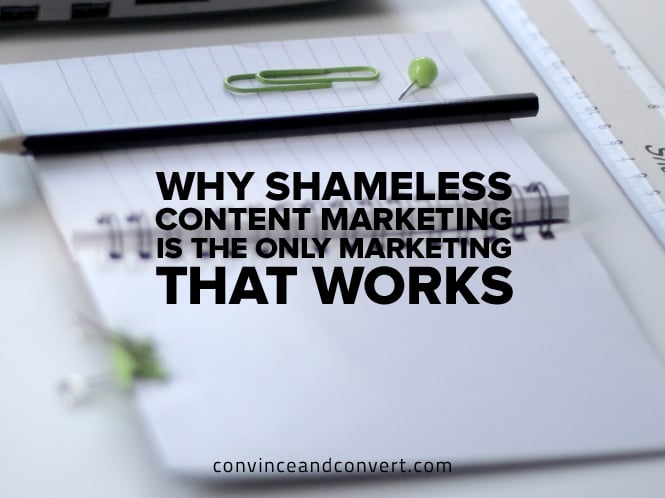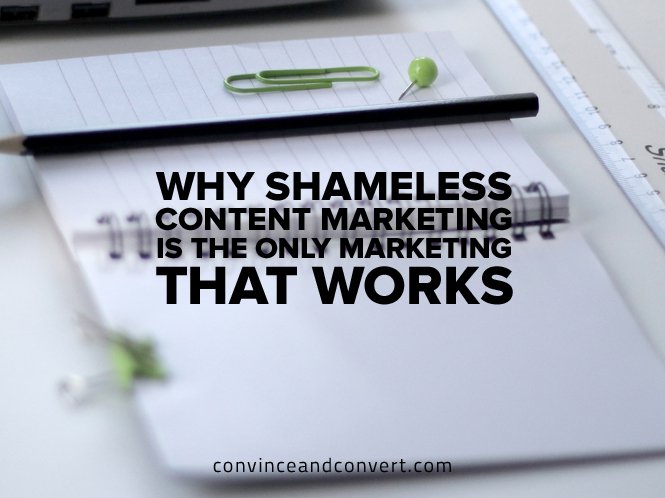Why Shameless Content Marketing Is the Only Marketing That Works1. Over the years, the hotel and restaurant guide became so prestigious, and the Michelin star-rating system so trusted, that it created a highbrow halo around the brand. This is what every content marketer wants: to create content that’s so great, so incredibly valuable, that the content itself becomes a sought-after product—but at the same time fearlessly and blatantly puts the brand front-and-center. (highlight to tweet) Some marketers have gotten too timid about putting their brands and products front-and-center in their content marketing campaigns. Content marketing is marketing. For much of the episode, the product is literally on display, and the Balvenie crew (including an on-staff coppersmith who has been tending to the distilling equipment for more than 50 years) get to talk about how and why they make a superior product. What’s impressive is that Red Bull splashes its name on almost everything, making it as much an extension of the brand as a media powerhouse as it is a content marketing operation for the soft drink brand. Though the short film didn’t obviously sell anything, it was just one part of a stealthy marketing juggernaut that created an aura of interest around the Monty the Penguin character. All four of these examples tell a common story—one of marketers who truly get it, who understand that consumers’ time is precious and that the best way to get their attention and engage with them is to give them content that’s worth their while. And when done shamelessly, it can make your brand not just the sponsor of great content, but the star of it.

Listen to this blog post as a podcast:
Among content marketing pros, two legendary, historic examples of content marketing ideas get cited again and again as ultimate success stories: the Guinness World Records franchise and the Michelin Guide.
The Guinness Book of Records was the result of brainstorming by Guinness Breweries exec Sir Hugh Beaver, who wanted to confirm that the golden plover was Europe’s fastest game bird after a 1951 hunting excursion. The annual compilation that resulted originally started as a promotional giveaway, but proved so popular that it became the best-selling book series of all time.
As for the Michelin Guide, it was first published by the French tire company in 1900 because André Michelin and his brother Édouard wanted to encourage consumers to hit the road and explore (i.e., use their cars for fun excursions, wear out their tires, and then buy more tires). Over the years, the hotel and restaurant guide became so prestigious, and the Michelin star-rating system so trusted, that it created a highbrow halo around the brand.
This is what every content marketer wants: to create content that’s so great, so incredibly valuable, that the content itself becomes a sought-after product—but at the same time fearlessly and blatantly puts the brand front-and-center.
I call this shameless content marketing. There’s no shame in selling overtly when you have great content. (highlight to tweet)
Some marketers have gotten too timid about putting their brands and products front-and-center in their content marketing campaigns. They’ve gotten so precious and pretentious about creating “pure” content that your average consumer might have no idea at all that a brand is behind the content. This is—what’s the right word?—stupid. Content marketing is marketing. It’s supposed to be self-promotional.
The good news for content marketers is that we don’t have to go back 100 years, or even 50 years, for awesome inspiration. I have four more recent examples that I think will also stand the test of time.
Coke’s “Share A Coke”
Coca-Cola’s global “Share a Coke” campaign—which puts common first names right on Coke cans, so you can, for example, “Share a Coke” with the name “Mary” on it with your friend Mary—first started in Australia in 2011. Over the course of that summer, the Coca-Cola Company sold more than 250 million bottles down under, where the population is around 23 million….

COMMENTS